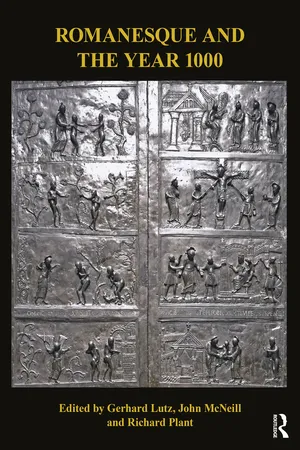
- 584 pages
- English
- ePUB (mobile friendly)
- Available on iOS & Android
Romanesque and the Year 1000
About this book
Romanesque and the Year 1000 examines the art and architecture of the Latin West between c. 970 and c. 1030, a period which witnessed crucial developments in iconography and stylistic expression across a wide range of media.
Despite the complex political situation in late 10th-century Europe – a period marked by chaos in some areas and the effective exercise of authority in others – the last quarter of the century saw an apparent upsurge in artistic production in the Empire, southern Britain, Lombardy, the Alps, and the Mediterranean, albeit one whose survival rate is low. The decades after the millennium have left a larger residue of work, notably in France, Catalonia and northern Italy, but were the 1020s artistically more dynamic than the 980s? How might we describe the cultural climate of the Latin West between c. 970 and c. 1030? Individual chapters examine the influence of Carolingian art on artistic production around 1000; the emergence of new approaches to architecture in France, Germany, England and northern Italy; and the response of artists to perceived order and disorder at the turn of the millennium. There are studies of architectural sculpture in Catalonia and Castile, new town foundation in Saxony, and monastic architecture in southern Britain, together with examinations of Ottonian sarcophagi, book covers in gold and ivory, the wall-paintings at Reichenau, the patronage of Willigis at Mainz and Robert the Pious in northern France, the early Romanesque of Poland and Hungary, and the reflection of a new type of affective piety in the manuscript illumination of late Anglo-Saxon England.
Romanesque and the Year 1000 presents a wealth of new research in artistic production at a critical period and is of interest to art historians, archaeologists, and historians alike.
Frequently asked questions
- Essential is ideal for learners and professionals who enjoy exploring a wide range of subjects. Access the Essential Library with 800,000+ trusted titles and best-sellers across business, personal growth, and the humanities. Includes unlimited reading time and Standard Read Aloud voice.
- Complete: Perfect for advanced learners and researchers needing full, unrestricted access. Unlock 1.4M+ books across hundreds of subjects, including academic and specialized titles. The Complete Plan also includes advanced features like Premium Read Aloud and Research Assistant.
Please note we cannot support devices running on iOS 13 and Android 7 or earlier. Learn more about using the app.
Information
Table of contents
- Cover
- Half Title
- Series
- Title
- Copyright
- Contents
- Notes on contributors
- Preface
- Image and society at Reichenau c. 1000
- Transforming the kingdom: artistic patronage and the establishment of early Capetian kingship in France
- A monarch and his buildings: the case of Robert the Pious (996–1031)
- The birth of Romanesque architecture in Aquitaine in the light of the patronage of Duke William the Great (995–1030)
- Precious book covers in gold and ivory (c. 970–c. 1030): between Carolingian tradition and new design
- In our founder’s image: cult and identity in Ottonian manuscript portraits of saints
- Order and disorder through the eyes of scribes and illuminators in the Kingdom of Pamplona c. 970–c. 1000
- After al-Manṣūr: art in Castile 970–1030
- Sculpture in Catalonia around the year 1000: ‘Corinthian’ capitals at Ripoll, Vic and Cornellà de Llobregat
- Otto III and the widow Theophanu: a Byzantine court in the West?
- The cathedral, castle, and the market town of Halberstadt around the year 1000
- Unpacking the Ottonian sarcophagus
- Willigis and his cathedral – the building of a new coronation church by the archchancellor and Archbishop of Mainz
- St Michael’s church in Hildesheim – a magic machine
- Looking north: architecture in Emilia (c. 1000)
- Imitatio imperii in early medieval Poland: some remarks contingent on an archaeological survey
- When gold was silver and silver was straw: the treasure of saints and warriors in Poland c. 1000
- The year 1000 in Hungary: turning point or continuation?
- St Laurence’s at Bradford-on-Avon, St Michael’s at Hildesheim and the use of squares in their planning
- England 970–1030: architecture and monumental arts of the monastic reform movement
- The representation of the Old Testament God in Anglo-Saxon manuscripts and the emergence of affective piety
- Trinity and transformation at the turn of the millennium
- Index